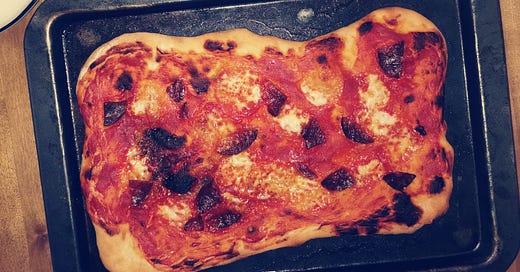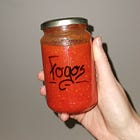Welcome to The Sauce, deep dives into food and drink culture.
A quick reminder that The Sauce is a reader-supported publication. Paid subscribers get access to everything The Sauce has to offer, from a deep recipe archive to every single essay. Hit the button below to sign up
When I was a kid, I hated pizza,
No joke, if I saw it on my school’s lunch timetable I would beg my mum to let me take that day off.
I’m not sure that five-year-old would believe that, 25 years later, pizza would become a thing. Multiple trips to Naples and Rome to compare the two styles. Epiphanies in dough, cheese and tomato.
During lockdown, my obsession went to new heights. I bought a Gozney pizza oven and used it at least twice a week, long after the lockdowns abated. Alas, these ovens are too heavy to import to Porto which has delighted my brother who is the long-term steward of my pizza oven baby.
The point is, pizza is life.

But pizza, we are told, is best made for a group. Dough proves better in bulk. If you live on your own, how can you possibly make pizza for one?
With my husband out of town for two months, I wasn’t going to let that sort of low-level thinking stop me from enjoying one of my favourite foods.
So I developed a pizza-for-one recipe to keep me company on my solo nights.
And damn. It works.
This is a no-knead, Roman-style pizza. Roman pizzas are made in hot electric ovens at lower temperatures than Napolitean which makes them easier to cook at home. Neapolitan simply doesn’t work unless you own an outdoor pizza oven that can get to that all-important 500C / 930F.
When you’re dealing with no-knead dough, time is your best friend. You can’t make this in two hours — 10 is the minimum. The best way is to make the dough before work, leave it on the counter and it’ll be ready by dinnertime. Or if you don’t want to make the pizza the same day, stick it in the fridge for up to three days.
If you go the fridge route, take the dough out at least two hours before shaping and cooking.
This recipe has been tested for a single portion but you can scale it up if you cook for more people.
Because dough works to specific proportions, the recipe is in grams and millilitres —they are more accurate. The most important thing is that you are looking for a 75% hydration dough. That means the volume of water is 75% of the volume of flour (for example 100g flour = 75ml water).
If you want to get geeky, you can buy specialised flour but you can also use strong white bread flour or general 00 pasta flour.
If you’re a hot sauce with your pizza kind of person (and why would you not be), this is the one I make for pizza night:
Roman style pizza
Serves one
The dough:
Keep reading with a 7-day free trial
Subscribe to The Sauce to keep reading this post and get 7 days of free access to the full post archives.







